|
|
|
|
The appalling reality of Bosnia’s missing dead
Thousands of families are still waiting for
news of missing loved ones, 25 years after the bloody Balkans war.
Ed Vulliamy meets the scientists piecing together the evidence from
mass graves, and the relatives hoping for justice – and a body to
bury.
By Ed Vulliamy
12 December 2016
|
|
|
|
Warning: Contains descriptions which
some readers may find upsetting
They are the unquiet dead. Laid out in
rows across the interior space of a former industrial building on
the edge of the Bosnian town of Sanski Most, the remains of human
beings, in various degrees of integration. Some of the skeletons are
almost complete, others just a pelvic bone and some assorted ribs,
arranged as though to await the arrival of more, towards the whole.
The eye sockets of their skulls seem almost to tell the violent
story of execution with a terrible silence; all sound in this space
is dulled, muted, by a pale light cast through high windows. There’s
a single bullet hole through the crown of each one.
This place was used to process wood
before Bosnia’s war of the early 1990s, and now it processes – it
endeavours to assemble – the dead. The remains are laid out on
raised trays, and at the foot of each lie possessions and clothing
found with the body when it was exhumed, invariably from a mass
grave. So to walk through this hall of death is also to walk through
these people’s lives and last moments. A pair of trainers here, a
checked shirt there, a watch or wallet. What made this person choose
a yellow sweater rather than another on a market rail, and chance to
be wearing it when taken out to be murdered? Why striped socks
beneath this half-assembly of bones, plain ones to accompany the
next? Who were these people? That is the question.
Because in addition to the spectral
presence in this building, run by the Krajina Identification
Project, there is diligent purpose. These dead people had been
missing for 24 years, along with tens of thousands of others, while
their families – survivors of the hurricane of violence that blew
through this corner of Europe in 1992 – searched, wondered, feared
the worst. Now they have been found – but who are they?
This facility is one in a chain that
seeks to answer that question, the work of which is the most
remarkable entwinement of science, human rights and justice in the
world today. The task of that chain is to locate and exhume the
40,000 people who went missing after the western Balkan wars – the
worst carnage to blight Europe since the Third Reich – then to
assemble their remains insofar as they can be found, identify them,
give them names, and return these dead back to the living for
burial. It is scientific work at its most committed and advanced,
helping to meet humankind’s most primal need: to bury or in some way
ritualise the remains of our dead.
|
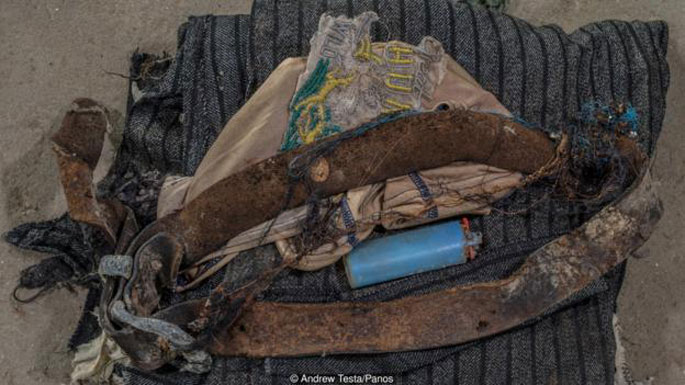 |
|
The belongings of the dead are
laid at the foot of each table holding a skeleton at
the Krajina Identification
Project in Sanski Most (Credit: Andrew Testa/Panos)
|
|
|
Beside a rough road that climbs a remote
mountainside, between the towns of Prijedor and Sanski Most, lies
the house that Zijad Bacic has rebuilt in the hamlet of Carakovo,
from the ashes to which it was charred in 1992, and where he now
plays football with his son, Adin. Beside it a modest marble
monument has been raised, on which are carved the names of 38
people, many of them members of Zijad’s extended family. Some of
them were killed on the night of 25 July 1992; others vanished.
Zijad was 15 on the night that – after his father and most other men
had been taken away to concentration camps – Serbian death squads
came back to “mop up” the women and children. He recalls it vividly:
“We were at home when we heard the soldiers’
voices. ‘Come on out! Come on out!’ My mother gestured to us: we
must. As soon as they went out, and the other families around us,
machine guns began firing. I recognised one of the men, the others
wore balaclavas. They were about five years older than me. I watched
my mother hit first and fall down, then my brother and sister – and
I ran behind a bush to hide. I stayed there until they had finished
shooting and shouting – I recognised another of the balaclava men
from his voice; they came from just down in the valley, they were
neighbours. I saw their arms shooting pistols at those who were
still living, until they stopped screaming.
“The killers went, and slowly I emerged. I saw two
other children, a boy of 10, a girl of 13. We looked at each other
as though we were ghosts. We were the only ones of 32 in the hamlet
to survive. I saw a man sitting on that bench there – he looked as
though he was asleep, but he was shot dead. I saw my mother – Sida,
she was born in 1946 – and my brother Sabahudin and sister Zikreta
dead in the garden.
“But I survived. I can still hear their voices,
the shooting. I was deported on the convoys, and went to a refugee
camp in Germany. And I never thought I’d come back here, but I
couldn’t sleep without knowing… what happened? Where were they? I
had to find my missing father, all my uncles, and to find where they
had buried my mother, younger brother and sister.”
|
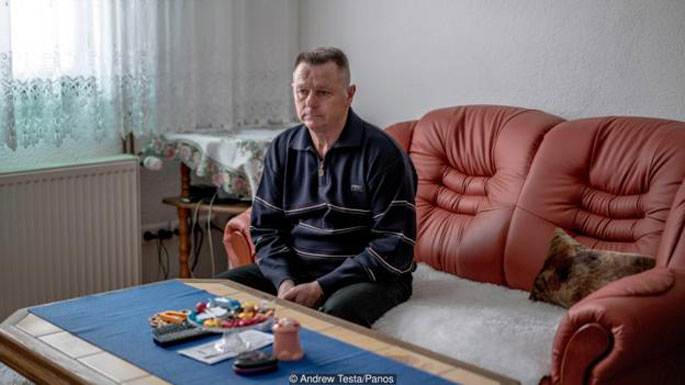 |
|
Fikret Bacic at his home in
Carakovo, near Sanski Most. 29 members of his
extended family were taken by Bosnian Serb forces
and killed in July 1992 (Credit: Andrew Testa/Panos)
|
|
|
It is mid-afternoon, the rain of morning banished
by a breeze from the west, and sunlight strokes the beauty of the
hillside. Blue and yellow summer flowers are scattered across the
meadows. Adin swings his scooter around. “I reported everything I
knew. I gave blood [to help investigators find DNA matches], and
started digging where I thought they might be,” says Zijad. “A
Serbian lady came: ‘Why are you digging here?’ I said I’m looking
for my family. She said: ‘They’re not here. Try somewhere else.’ I
believe that 99% of the people here know exactly where they are.
Only they don’t care to tell me, or they’re too afraid of the people
who did it. But I need to know where. I need funerals. I need
trials.”
There have been seven arrests in connection with
the extermination of the Carakovo villagers. Two of the accused have
been released on bail under house arrest, and Zijad thinks they are
the men he recognised on the night of the massacre. “That’s one of
their houses right there,” he says, pointing towards a white
building on the valley floor. “We’re hoping that these trials will
reveal where my family is. I’m going to testify. Even though we’re
surrounded by them, I have no fear of anyone or anything any more.
All I have is my wife and son, and my only need in life – which is
to find those I have lost.”
Where Zijad’s mountain lane meets a tarmac byway,
there stands a little shop kept by Zijad’s uncle, Fikret Bacic, who
takes my notebook and writes a list of the names of his extended
family who went missing during the last week of July 1992. It takes
him a long time; there are 29 of them, including his mother Sehrisa,
his wife Ninka, son Nermin, who was 12, daughter Nermina, who was
six, four brothers including Zijad’s father, three sisters, several
aunts, uncles and cousins. Of the 29, 19 are children; the youngest
was two.
Fikret’s eyes are the saddest imaginable, as
unfathomable as his loss is inconsolable. “They were taken and
killed by the viaduct, just there, by the main road,” he points to a
railway bridge beneath which we’d just driven. “For years, I’ve had
no idea where they were buried.
“I was working in Germany when it happened; of
course I couldn’t believe it.” The first thing Fikret did was to
tour refugee camps across Europe: Holland, France, Austria, Croatia.
“I hardly knew what I was doing, like a wild hunter-dog. But
nothing. So there was only one thing to do: come back, and I never
thought I’d do that, back to the destroyed house. But I did, in
1998, only to start looking, for I had nothing else to do with my
life but find the bodies and the people who did this. I asked a
Serb, who had been the best man at my wedding, raised by my
grandmother: where are they? There are not many people I can ask, I
pleaded with him, I just need to know who did this, and where they
are buried. He just said: ‘I don’t know, I was not there.’ I could
tell he was lying. I went to the police in Prijedor, but everyone
knew it had been the police who organised the hiding of the bodies.
Two men knew – I had a feeling. I went to the house of one, but he
had guests and would not talk. Then the other, but he had died. Then
I realised the only thing to do was to start digging.
“I dug everywhere. I helped wherever there was a
dig.” Fikret went to the mass grave found at the village of Kevljani
in 1999, next to a concentration camp established by the Bosnian
Serbs at Omarska; it had been found when villagers spotted strange
vegetation growing, of a kind the soil beneath it would not normally
nurture. There was no sign of Fikret’s family.
Then, in 2004, work began at a second mass grave,
also near Omarska, at Tomasica. Fikret was there, digging, but the
bodies found there still did not include his family. “None of us
knew,” he says, that “we were only 100 metres from the biggest mass
grave of them all”.
We sit in Fikret’s yard, beside the shop, roses
climbing the fence, neighbours passing by, saluting him. He sips a
glass of Nektar beer, a Bosnian Serb brew. “The pain doesn’t go
away, it gets worse, stronger, the longer it lasts,” he says. “I
went to the state court, and an American prosecutor showed an
interest for a while, but then said he had to leave and take another
job. After a while, I gave up, I couldn’t go on any more.” Then, in
2013, there was a bigger, macabre discovery at Tomasica: hundreds
more bodies, buried, hidden – but now revealed. Fikret Bacic was
there moments after the first earth was broken and news sent abroad.
“Whenever I could go, I was there. It seemed that
they had buried them village by village, in order of where they’d
been killed along the road from Prijedor. Go deeper, go deeper, we
all said. We had all given blood by now, and first, they started to
find my neighbours, the Tatarevic brothers, up the lane there. Then
a cousin of mine. And then my brother Refik – no documents, but the
DNA matched.
“It’s hard to say what I felt. It was like someone
who belongs to me coming back from 10 metres deep. He’s my family.
And then another body comes out, and it’s not one of mine, and you
feel so bad. I did that for three months, until the last body was
found and either identified or not. Now we must wait for another
grave to contain the women and children: two were found at Tomasica,
but still 17 kids are missing, aged two to 16. You know, I can’t
believe I’m saying this; it leaves a bad taste in my mouth, and in
this lovely evening, for me to have to tell you that all this is
true, that this is what people do to each other.”
|
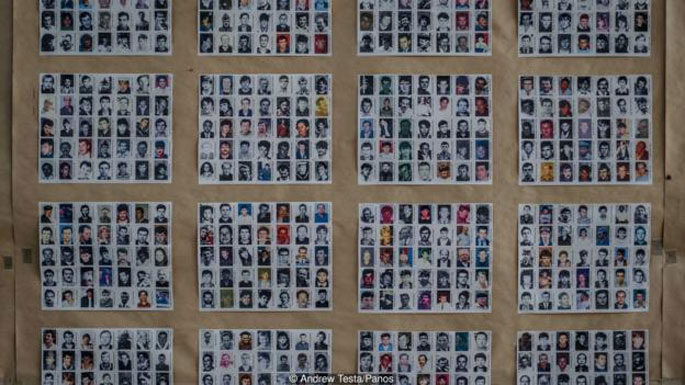 |
|
Photographs of the missing at the
Krajina Identification Project in Sanski Most
(Credit: Andrew Testa/Panos)
|
|
|
The driving force behind this search for the
missing dead in the blood-drenched Balkans is the International
Commission on Missing Persons (ICMP), founded in 1996 on the basis
of an initiative by President Bill Clinton at a G7 summit in Lyon,
France. ICMP arrived to urge the location and identification of
30,000 people in Bosnia (and 10,000 more across the region),
‘missing’ in mass graves. Over two decades, this it has done, both
physically and scientifically, spearheading a battle against what
appeared to be all odds. Most have been found and their remains
returned to their families – but 8,000 in Bosnia are still missing.
The scope of what ICMP has been doing here in
Bosnia since its foundation is almost beyond comprehension.
Originally a non-governmental organisation, it was recently given
full international legal status, covered by treaty. So now, from
these benches holding their skeletons in Bosnia’s rural reaches,
ICMP takes on the world. This work addresses the existentially
offensive limbo suffered by tens of millions of families around the
planet – the state of not knowing, not having so much as the remains
of a child, husband, wife or parent, to do what humans have always
done: bury them.
Gruesome battle
Over the summer of 1991, the break-up of
Yugoslavia began to turn bloody, first in Slovenia, then Croatia,
then Bosnia, as Yugoslav republics sought independence and Slobodan
Milosevic’s government inBelgrade sought to establish borders for a
“Greater Serbia”, which spread into both Croatia and Bosnia and
entailed the elimination, through death or deportation, of every
non-Serb on the territory.
In Bosnia, a savage pogrom was unleashed in spring
1992, mainly at first against Slavic Muslims in the east and against
Bosniak Muslims and Catholic Croats in the north-west Krajina; the
Bosnian capital of Sarajevo was subjected to relentless siege and
the stillborn republic torn apart.
It was my accursed honour to report on this war,
and in August 1992 to uncover concentration camps, established by
the Serbs for Muslim and Croat inmates, near the town of Prijedor in
Krajina. The carnage dragged on until soon after the Srebrenica
massacre three bloody years later.
I have kept in touch with the survivors of, and
those bereaved by, those camps, and come to understand how the
outrage of “disappearance” inflicts an immeasurable pain on those
who remain. I return to Bosnia every year for commemorations at the
camp, and hear how, in so many ways, those words “missing” and
“disappeared” are crueller than “dead”; they leave the mothers,
fathers and family without so much as an interment, a grave to
visit, an account of what happened and why.
By the time Bosnia’s war ended, in 1995, the
discipline of forensic anthropology in pursuit of the missing had
been advanced significantly: in theory by an American called Clyde
Snow, and in practice by a bold and radical group, the Argentinian
Forensic Anthropology Team, established in 1986 to trace and
identify the thousands forcibly “disappeared” during that country’s
military dictatorship from 1976 to 1983. “For the first time in the
history of human rights investigations,” wrote Snow, “we began to
use a scientific method to investigate violations. Although we
started out small, it led to a genuine revolution in how human
rights violations are investigated.” The scale of the catastrophe in
Bosnia meant that the search needed to draw on that revolution, to
which ICMP would in time add a second revolution: the introduction
of DNA matching.
When investigators from the war crimes tribunal in
the Hague first arrived in 1996 to build a case against the
perpetrators of the Srebrenica massacre, their first preposterous
task was to search for the evidence: its victims, 8,100 murdered men
and boys ploughed into the ground.
They were led by a French investigator called
Jean-Rene Ruez, an anthropologist called Richard Wright, who had
worked on World War Two graves in Ukraine, and a former
archaeologist of ancient and medieval London, Ian Hanson – who is
now deputy director of forensic sciences, anthropology and
archaeology at ICMP.
|
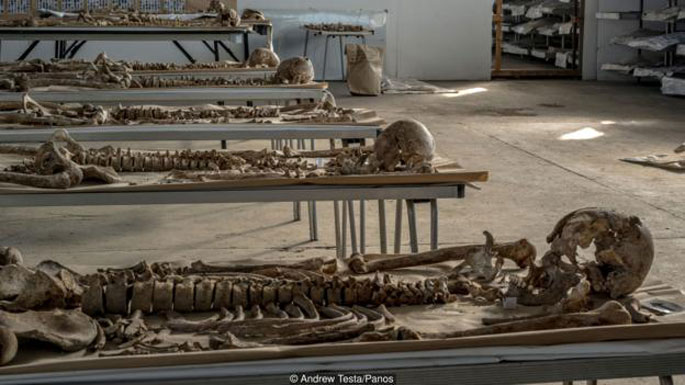 |
|
Remains of people massacred
during the Bosnian war are laid out on tables at the
Krajina Identification
Project in Sanski Most (Credit: Andrew Testa/Panos)
|
|
|
The modern discipline of finding and identifying
the hidden dead, Hanson says, has its roots in WWII: a famous case
was the identification of more than 20,000 Polish officers massacred
at Katyn in what is now Russia in the spring of 1940. The USSR
insisted they had been killed by the Germans, but a German
investigation disproved this, forensically demonstrating that they
had been murdered by the Russian political police, NKVD. “For once,”
concedes Hanson, “I’m afraid the Nazis were right.”
Work at Srebrenica began on what were thought to
be the five mass burial sites – each containing many separate graves
– in which the dead had been buried and left hidden. Then a macabre
truth emerged: testing showed that body parts from what became
called the primary graves had been moved to secondary ones, to hide
evidence. Sometimes, they had even been disinterred and reinterred
again, into tertiary graves. With two implications: firstly, that
more than a million-and-a-half bones and body parts from 8,100
people were scattered across innumerable sites; and secondly, that
the few byways of rural eastern Bosnia had for weeks, months, been
heaving with trucks carrying the rotting, stinking remains of these
people – some 3.2 tonnes of “putrefactive material” – hither and
thither. Yet no one said a thing.
“We call this ‘grave-robbing’,” says Hanson.
Enquiries by him and others found that the Serbs had arranged
secondary graves “to be located in places where there had been armed
confrontations, so that they could plead that massacre victims were
killed in combat. It was all very carefully worked out.”
The search for the missing was initially regarded
as a humanitarian affair. But the war crimes tribunal’s motivation
was prosecutorial. When ICMP arrived in 1996, it dovetailed into
that notion, so that its approach was altogether new, and tougher:
finding the hidden dead for human reasons, but also seeking evidence
to establish what happened and uphold the rule of law. The victims
clearly approve: of the relatives of the missing who gave blood
samples in pursuit of a DNA match, 90% agreed to allow any results
to be used in evidence at trial.
Denial and obstruction
From the outset, the process of finding and
identifying the dead was hampered by a toxic atmosphere of denial,
non-cooperation and sectarian structures that dealt with their own
side’s losses and no one else’s – markedly among the main
perpetrators responsible for more than 80% of the missing, the
Bosnian Serbs.
“When we first arrived,” says Hanson, who was then
with the war crimes tribunal, “the people with the information we
needed were not nice guys; they were guys with guns not wanting us
to do what we had come to do. We used to go into the police stations
that were supposed to be helping us, and see pictures of ourselves
on the wall: ‘Do Not Cooperate with These People’!”
To that end, ICMP stepped in, not just to help
look for bodies and nurture the expertise to do so, but to “assist”
the Bosnian government in turning a haphazard, sectarian search into
a systematised, centralised operation. Hanson uses the word 'assist'
but moves his flattened palms against thin air making as if to push
it.
The initial search focused mainly on Srebrenica.
Identification both there and in Krajina was at first done using
classical anthropological methods: identifying possessions, dental
treatment, clothing etc. But from 2000, ICMP began using DNA samples
from blood given by relatives of the dead, matching them with those
gleaned meticulously from samples of excavated bone. This was the
second revolution in forensic anthropology and the figures speak for
themselves: in 1997, seven positive identifications; in 2001, 52; in
2004, 522.
Srebrenica has become iconic of Bosnia’s carnage,
yet it tends to detract from other atrocities over the three years
of the war. Bosnia is a country without a reckoning, a call to
account. And nowhere is this more brutal than in Krajina, with the
second-biggest concentration of mass graves, the first of which was
found in 1999 at Kevljani. Near what had been the iron ore mine of
Omarska, it contained 143 bodies of men murdered in the camp.
A second grave was found at Kevljani, this one
with 456 victims of Camp Omarska, and others around a mining
facility at Ljubija. But only in 2013 did Bosnia’s largest mass
grave away from Srebrenica come to light, a few kilometres away down
a dirt track from Omarska, by which time the site of the camp had
been re-opened as a mine: the grave at Tomasica in which Fikret
Bacic found his brother. The site looks like a pond now, water
settled in the sunken earth, from which reeds grow. A family from
the nearby Serbian village walk up the track towards it, carrying
fishing rods. But for more than a year, this was a scene unlike
almost any other in Bosnia since the war.
|
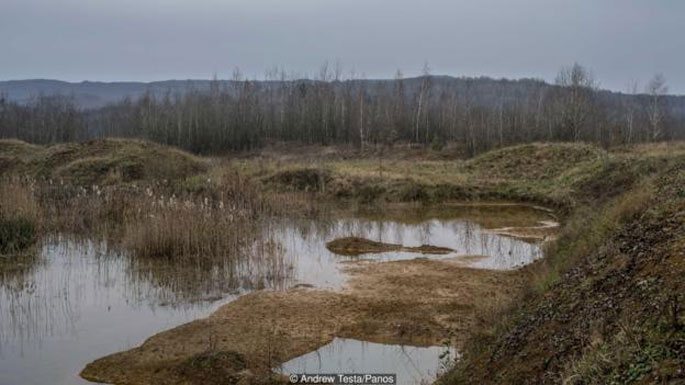 |
|
The site of the mass grave at
Tomasica. So far more than 400 bodies have been
exhumed,
but authorities believe many more may be buried
there (Credit: Andrew Testa/Panos)
|
|
|
“They arrived here, all of them,” recalls Dijana
Sarzinski, mortuary manager at the Krajina Identification Project
(KIP) facility on the edge of Sanski Most. “It’s one thing to exhume
bodies from a grave of 11 people, as many of them are. But here were
434, possibly more.” The figure would later rise to nearly 600.
“They had been preserved in clay for 20 years, tightly packed
together, glued by decaying tissue.” Here was the KIP’s extreme
exposure to a science called taphonomy – that of the decomposition
of organisms, known by the initials FBAAD: fresh, bloat, active,
advanced, dry. “It’s a bit different when you see people staring at
you from the earth: their eyelashes, lips, fingerprints. You get
used to the smell of bodies, but not like they were at Tomasica. We
all had PTSD after Tomasica.”
Investigators at Tomasica found a terrible echo of
the grave-robbing that they had discovered at the other end of the
country: evidence of matching body parts in different graves. The
practice of disinterring and reinterring bodies, by now so
perturbingly familiar from work around Srebrenica, had actually
begun here three years earlier than it had there.
One of the human agonies of this separation of
body parts is that some people are identified on the basis of just a
few bones, and it is up to the families to decide whether they have
enough to bury or whether to wait for more.
“People find their missing, but not complete,”
says Amor Masovic, who set up the Muslim-Croat Federation Missing
Persons Commission after the war. “They don’t know if they have
peace or not. They may bury a few fingers and a leg, and five years
later there’s a knock at the door, it’s the left leg now, two years
later a piece of skull. It’s part of that awful limbo.” At one
point, Islamic spiritual authorities decreed it irreligious to bury
less than 40% of a body, further exacerbating the trauma for those
believers trying to deal with fragments.
“During the siege of Sarajevo,” recalls Masovic,
the Bosnian Serb general Ratko Mladic “told his gunners: ‘Drive them
to the edge of madness’. Well, this was the same principle, but for
the madness to remain after the war. The madness of relatives of the
missing, which will remain until their own deaths. They appear as
statistics, all 40,000 of them. But each number is a horror story
that people are going through, every one of them like a novel you
could read for the rest of your life.”
|
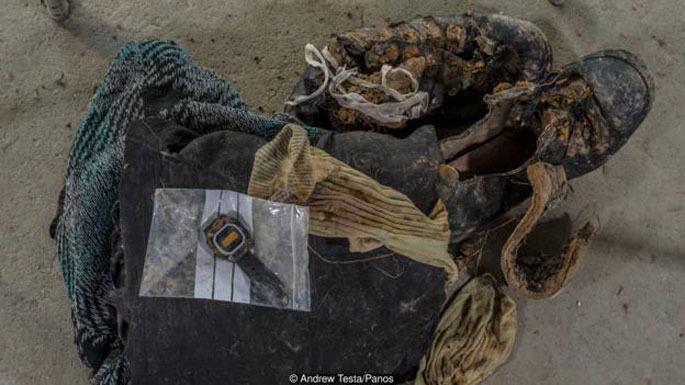 |
|
Remains of a life before the
horror (Credit: Andrew Testa/Panos)
|
|
|
The bodies from Tomasica, like those from all
around Krajina, come first to the identification facility on the
edge of Sanski Most. The standard operating practice here is the
world’s “gold standard”, says forensic anthropologist Dijana
Sarzinski. Remains are meticulously washed, and a biological profile
established. Scientists and technicians work in silence, clad in
blue tunics and masks, washing body matter, cleaning bones with
toothbrushes. The bones are subject to a physical decontamination,
followed by removal of any exogenous DNA that may have attached
itself. A small sample of bone – a “bone window” – is then extracted
with precision blades, to be passed on to the laboratories. “We’re
not allowed, as anthropologists, to determine a cause of death –
that’s for the pathologists,” says Sarzinski. “But we can prepare
the cases and point out possible causes.” The single bullet holes
through the skulls of these men from Hozica Kamen are articulate
enough.
The numbers arriving from Tomasica were so
overwhelming that the bodies “had to be treated with salt, basically
mummified, using a method thousands of years old, preferred by the
ancient Egyptians,” she says. “They had been preserved in clay for
so long, and very quickly decompose – through dessication of tissue,
bugs and maggots”.
The bodies from Hrastova Glavica, a desolate
mountain hamlet near Sanski Most, presented a different challenge.
In August 1992, the Serbs brought 125 prisoners here by bus from the
camps at Kereterm and Omarska. They took them off the buses bound in
groups of three, gave each man a cigarette, shot them and slotted
them individually down a crevice in the rocks. (The grave was found
because one man broke free and survived to tell the tale.) “Body
parts had been squashed together for so long, they were all
co-mingled, tissue stuck together, tissue and bone from one body all
mixed up with another,” Sarzinski says.
Once the bones are ready, they have to be
re-associated with others from the same skeleton; this is crucial to
establish what grave-robbing has taken place. “It became very
quickly clear that of the 434 bodies we received from Tomasica, 56
cases of body parts needed re-associating with cases which had been
previously identified at Jakorina Kosa,” says Sarzinski. But others
enter into the category of ‘NN’, no name.
ICMP started an NN Project in 2013, explains
Sarzinski, “to give names to associated skeletons that had none”.
The project is “all-encompassing”, she says. “It throws together
everything we have and can get, from the police, the families, the
prosecutor’s office, seeking out new areas of investigation and
pushing for them, trying to fit any and every tiny part in a huge
jigsaw puzzle.”
I ask whether Sarzinski would like to come to this
year’s commemoration at Omarska – put faces to the bones, as it
were. “I can’t,” she replies. “I have to do this job for what it is.
I can’t afford to cross that line.”
|
 |
|
Victoria-Amina Dautovic, a
forensic scientist, trains on a synthetic skeleton
at a mortuary facility in Visoko, near Sarajevo
(Credit: Andrew Testa/Panos)
|
|
|
One of the reasons that so many of the dead in
Tomasica have been identified is that many relatives from around
Prijedor had given blood samples. ICMP’s revolutionary DNA-matching
process proceeds from Sanski Most and the other mortuaries to the
organisation’s core, in Sarajevo. The kernel of this entire
operation is the DNA lab, a small, unprepossessing room on the first
floor of a modern office block.
Ana Bilic is deputy head of ICMP’s laboratories
division. Like Sarzinski, she is young, and testimony to this
singularly strange speciality Bosnia’s tribulation has produced:
born in Sarajevo, she trained at the university here before
completing a Master’s at Halifax, Canada, and returned to do this
work. There is a logic to Bosnia becoming a world leader in this
grisly expertise, in addition to the experience of war: medical
science was practised in communist Yugoslavia to a markedly high
standard, and science now serves as some kind of absolute that
transgresses the bitter divide of war, and might even transcend it.
The Sarajevo facility is the hub of a network of laboratories in
Bosnia, Croatia and Serbia – politically balanced.
It takes three weeks for DNA-matching to take
place. On one side of the process, there are the reference samples
of blood from relatives of the dead, collected during exhaustive
drives in Bosnia and among the scattered, shattered diaspora across
Europe and America. Bilic shows me one of the so-called IsoCode
cards on which blood arrives from the relatives: six drops from the
right index finger, air-locked in a plastic bag. The blood is valid
for DNA testing for 20 years, explains Bilic. The DNA in the blood
is then bar-coded, given a digital existence that may or may not
help it find its match.
On the other side are the bone samples from places
like Sanski Most. The scoured bone windows are “ground into a fine
powder, to increase the surface available for testing,” says Bilic,
and 0.5–1g of the bone powder is, like the blood, bar-coded inside a
small plastic bag. Bilić produces one: “Some of these people have
been dead a long time, stacked up in clay, rivers and canyons, and
it’s a challenge to extract the DNA.” She shows a chart
demonstrating that some bones are easier than others – teeth,
vertebrae and talus bones (in the ankle) are best, she says, for
extraction of osteocytes, a variety of cell in which DNA is more
likely to be preserved.
The method of DNA identification preferred by
ICMP, explains Bilic, is nuclear short tandem repeat. It concerns
the number of times a nucleotide is repeated consecutively on the
DNA strand. She says that this method has a “higher discriminatory
power” than any other, “and a certainty threshold of 99.95%,
sometimes higher, often 99.999 recurring. As close to certain as it
is possible to get.”
And into the computer they go: bar codes from the
bone, and those from the blood samples – sorted by a specially
devised “blind” programme – blind, not least, to political rhetoric,
manipulation, denial. Cold, clean science to enact, says Bilic,
“blind searches of kinship analysis, so that the possible
identification of the person can be made. Without the use of DNA,
there would be no way to put these parts of the puzzle together
again.”
The system’s near-perfection produces many
matches, but also leads to a new set of problems: the discovery of
mis-identifications using earlier, less accurate methods. As Amor
Masovic explains: “About 8,000 were identified through classical
methods, of which some are completely wrong – they have two left
legs, they are part-one person, part-another.
“With DNA testing, some families realise the
person they buried 15 years ago was a mistake. They will know that
their son has been identified, but is in a mortuary in Sanski Most,
or Banja Luka, not in the ground. And this agony begins: of
disinterring the misidentified body, and replacing it with the
correct remains.” But the Muslim-Croat Federation Missing Persons
Commission has a policy, Mašovic says: “We will not disturb people
in the ground – because it only disturbs the families – unless we
have found another body to replace it. We can correct a mistake, but
we can’t take a body from a family if there is none to replace it.”
Down the corridor from Bilic’s lab, Ian Hanson’s
depth of commitment allows him no respite; he almost corrodes
himself with his own questions. “When I moved here from the ICTY
[International Criminal Tribunal for the former Yugoslavia, in the
Hague] in 2009, we’d found 70% of the missing. Why are we not
finding more? Why are there are still 8,000 people missing? There
are reasons for that.”
The cruellest, most effective, impediment to their
work is the rule of silence – observed when body parts were being
moved along lanes near Srebrenica and Omarska, and observed still.
“One of the constant issues we face,” says Hanson, “is that someone
knows where the graves are, but everyone gets on with their
business. People know, without giving us the information. It’s an
issue among the Serbs in Krajina, the Bosniaks in Sarajevo, the
Croats in Mostar. They’re reluctant to come forward, or scared of
intimidation.”
A series of US government cables from 2008 –
posted by Wikileaks – show how much the Serb administration,
Republika Srpska, has impeded efforts to find the missing. One says
that “authorities have taken a series of steps to undermine the
ability of the state-level Missing Persons Institute (MPI) to
locate, exhume and identity victims”. A further cable says that a
separate Serb-only missing persons agency has taken “increasingly
bold steps to undermine” the central, non-sectarian MPI. This Serb
agency is empowered to “withhold information from MPI,” the cable
says, and has even engaged in “confiscation of MPI material”.
“What is the incentive for people to help us when
the risk is so high?” asks Hanson. “They all keep quiet, not even
wanting to implicate the others, in case they implicate themselves.
But they all want an outcome. We can go into a room full of people
who do not want to work with each other – but they all know that we
are the ones who do the DNA tests that lead to bodies being found.
So the question to them all is: Do you want these people found or
not?”.
|
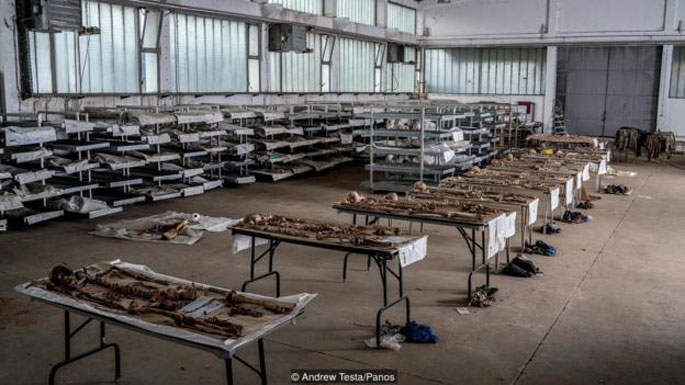 |
|
DNA analysis has transformed the
work here (Credit: Andrew Testa/Panos)
|
|
|
Hava Tatarevic’s garden is ablaze with the palette
of summer. Scarlet begonias, white marguerite daisies with yellow
suns at their core, deep pink climbing roses – and smoky blue
forget-me-nots, for that Mrs Tatarevic could never do, whether
before her husband and six sons were found, or after.
She is the older sister of Zijad Bacic’s murdered
mother, and she survived – “if you can call this survival,” she says
– to tell the story of the night she lost her family, some weeks
before the murder of Zijad’s. “It was one of the first days of the
war. Men came to the house, and took them all away. They took my
husband, Murharem. And six of my sons: Senad, Sead, Nihad, Zijad,
Nidzad and Zilhad. All apart from my youngest, Semir. They said he
was too young. They came to the house with guns, and balacavas, and
just said: ‘You’re coming with us, if not we’ll kill you all, here
and now.’ I started to cry, and they said: ‘Don’t worry old lady,
they’ll be back.’ And marched them down the hill.
“I never saw my sons again, but a few days after
that, the same men came back and ravaged everything. They stole what
they wanted from the house, ate and drank what was here, and smashed
the rest. They killed all our animals. They said there was a
restaurant down on the road by the viaduct, where I was supposed to
go. But they said: ‘Don’t go there, it’ll upset you. It’s full of
children hungry and crying’ – I think many of them were killed. So I
was taken instead to the camp at Trnopolje, then on the convoys to
Travnik. From there, after a long time, my sister came and took me
to Croatia, and then Germany.”
Mrs Tatarevic pauses. The only sounds audible are
bees across the flowerbeds and the hum of a tractor in mid-distance.
She offers coffee, but it seems too much trouble. “I started looking
for them all right away,” she continues after a while. “First of all
I looked around the refugee camps. I wrote letters. People would
come to Germany from all over the diaspora, and I’d ask them: have
you seen my children? Have you seen my husband? I started coming
back in summer to rebuild the house, and plant things. And I asked
everyone, even the Serbian neighbours: have you seen them? Do you
know where they are?
“I went to the police in Sanski Most to register
them. I gave my blood sample to the people from Sarajevo. I went to
Trnopolje where the concentration camp had been, and asked people
there. I don’t know how I survived the pain. I don’t know if I did
survive the pain. I just wanted to know – how did they die? Are they
still alive? Might they come back to the village while I am in
Germany? If they were dead, all I wanted to do was to hold their
bones in my hands, and find a place of green grass under which to
bury them, and say my prayers and say: there they are, my dead
sons.”
Then, after almost a quarter-century of this
purgatory, she learned about the new mass grave found in 2013. “I
think I knew, I had a sense, something told me this was it. We went
to Bosnia on the Sunday, to the grave site, to Tomasica. There was a
grave full of children and young people from our village. And there
was one of my sons, Senad, still with his wedding ring on. And I
knew, even before they took the others to the laboratory, a voice
told me it was them, the other five. And yes, later, a woman came:
‘We have your husband, we have your sons,’ she said.”
Dusk falls across the heat haze. The sound of the
evening muezzin drifts across the valley – once intended never to be
heard here again. Insects buzz across the flowerbeds as the cool of
evening descends. The brutal bedlam of those days and nights 24
years ago seems unimaginable, but Mrs Tatarevic’s gracious presence,
and falling tear, make it only too cruelly real. “It is hard enough
to lose a child, I think. But to lose them all? What can I say? What
can I do? I cannot jump out of my skin into another. I just have to
do what I can with my own. And they are buried now. The wait is
over.”
--
Additional research by Elsa Vulliamy and
Victoria-Amina Dautovic.
This article was first published by Wellcome
on Mosaic and is
republished here under a Creative Commons licence. |
|
|
|
BOSNIA |
PAGE 1/2 ::: 1 | 2 |
|
|
|
|
